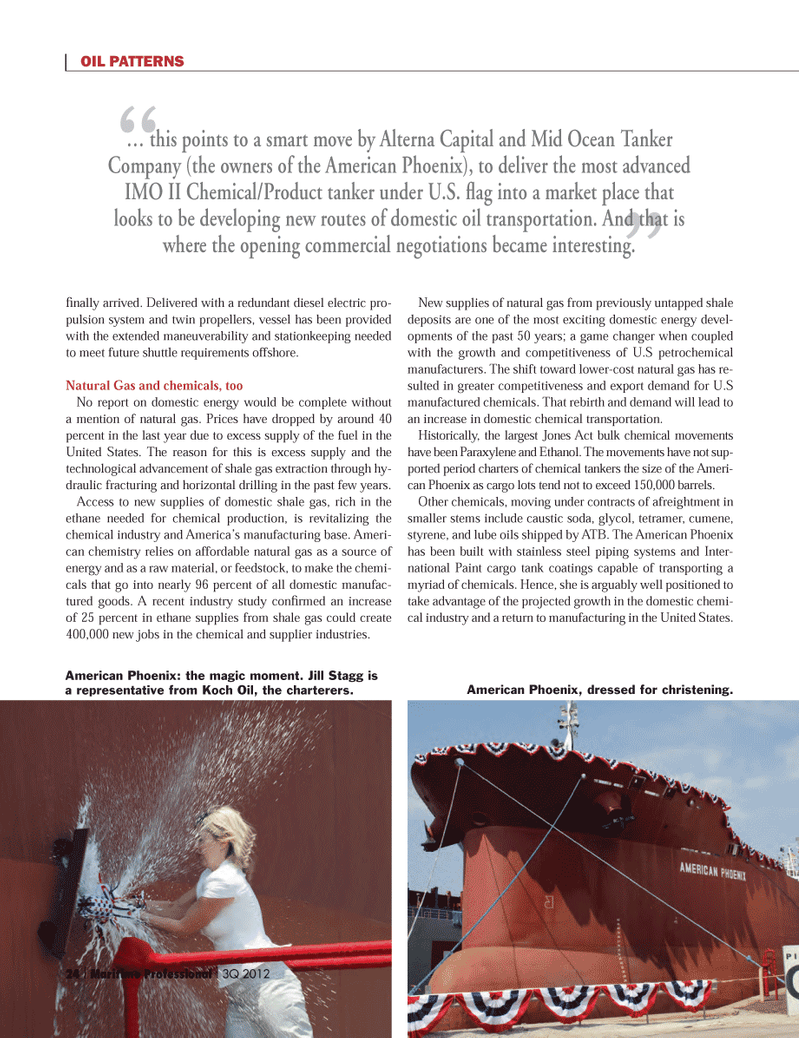
Page 24: of Maritime Logistics Professional Magazine (Q3 2012)
Classification Societies, Quality & Design
Read this page in Pdf, Flash or Html5 edition of Q3 2012 Maritime Logistics Professional Magazine
Þ nally arrived. Delivered with a redundant diesel electric pro- pulsion system and twin propellers, vessel has been provided with the extended maneuverability and stationkeeping needed to meet future shuttle requirements offshore. Natural Gas and chemicals, tooNo report on domestic energy would be complete without a mention of natural gas. Prices have dropped by around 40 percent in the last year due to excess supply of the fuel in the United States. The reason for this is excess supply and the technological advancement of shale gas extraction through hy- draulic fracturing and horizontal drilling in the past few years. Access to new supplies of domestic shale gas, rich in the ethane needed for chemical production, is revitalizing the chemical industry and AmericaÕs manufacturing base. Ameri- can chemistry relies on affordable natural gas as a source of energy and as a raw material, or feedstock, to make the chemi- cals that go into nearly 96 percent of all domestic manufac- tured goods. A recent industry study conÞ rmed an increase of 25 percent in ethane supplies from shale gas could create 400,000 new jobs in the chemical and supplier industries. New supplies of natural gas from previously untapped shale deposits are one of the most exciting domestic energy devel- opments of the past 50 years; a game changer when coupled with the growth and competitiveness of U.S petrochemical manufacturers. The shift toward lower-cost natural gas has re- sulted in greater competitiveness and export demand for U.S manufactured chemicals. That rebirth and demand will lead to an increase in domestic chemical transportation. Historically, the largest Jones Act bulk chemical movements have been Paraxylene and Ethanol. The movements have not sup- ported period charters of chemical tankers the size of the Ameri- can Phoenix as cargo lots tend not to exceed 150,000 barrels. Other chemicals, moving under contracts of afreightment in smaller stems include caustic soda, glycol, tetramer, cumene, styrene, and lube oils shipped by ATB. The American Phoenix has been built with stainless steel piping systems and Inter- national Paint cargo tank coatings capable of transporting a myriad of chemicals. Hence, she is arguably well positioned to take advantage of the projected growth in the domestic chemi- cal industry and a return to manufacturing in the United States. OIL PATTERNS ??? this points to a smart move by Alterna Capital and Mid Ocean Tanker Company (the owners of the American Phoenix), to deliver the most advanced IMO II Chemical/Product tanker under U.S. ag into a market place that looks to be developing new routes of domestic oil transportation. And that is where the opening commercial negotiations became interesting. American Phoenix: the magic moment. Jill Stagg is a representative from Koch Oil, the charterers. American Phoenix, dressed for christening. 24 | Maritime Professional | 3Q 2012

 23
23

 25
25
